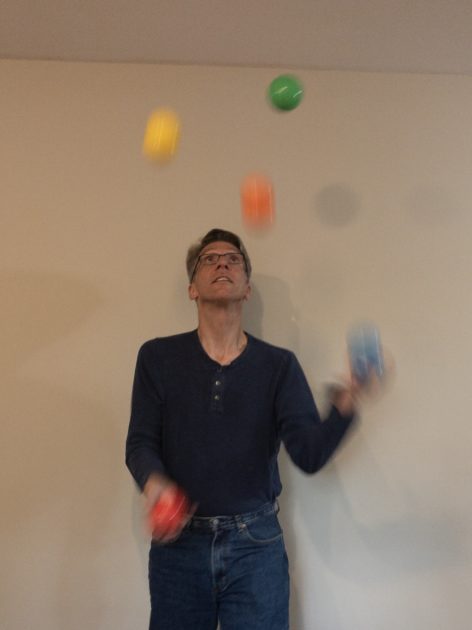While it should come as no surprise that our professors have hobbies and passions outside of the classroom, sometimes this can be hard to remember in the wake of papers, exams, and the struggle to maintain good grades.
For one professor, however, finding the balance between teaching and hobbies has been a breeze.
Dr. John Stadler, professor of mathematics, computer science, and physics, has had a passion for juggling since he was a teenager.

“I learned to juggle two beanbags in one hand, because my brothers had these books called ‘Juggling for the Complete Klutz,’” Stadler said.
He quickly found rivalry in the form of his brothers, who prompted him to learn how to juggle three bean bags with two hands, and he was later pushed to even greater heights by a friend from high school, who also knew how to juggle and challenged him to grow further.
“He could do four, so I had to learn how to do four,” Stadler said. “The two of us were really beneficial to each other because we would push each other.”
In addition to Stadler’s brothers and friend, another source of juggling inspiration was the young and skilled juggler Anthony Gatto.
“When I first heard of him, he was about 13 or 14 years old,” Stadler said. “Everyone was watching this kid grow up, and he’s still got world records.”
As for what made the connection in Stadler’s mind between math and juggling, Stadler said mathematician and juggler Ronald Graham first brought together the two concepts.
Stadler was inspired by this after hearing Graham talk at The Ohio State University.
So, how is juggling related to math? According to Stadler, it’s connected to modular arithmetic, otherwise known as “clock arithmetic.”
“When you’re juggling and you throw a ball up, you know about how many throws you have before it’s going to come down again,” Stadler said. “So you can use a list of numbers to represent a juggling pattern. One juggling pattern that’s pretty well-known is ‘four-four-one.’”
But what does ‘four-four-one’ mean?
“The first time you throw a ball it’s going to be caught four throws later, the second one is going to be caught four throws later, and the third one will be caught one throw after that,” Stadler said. “And that repeats ‘four-four-one,’ ‘four-four-one.’”
Not only does Stadler use juggling in the classroom, but he has also performed at Kings Island and has spoken about the connection between math and juggling at COSI.
Out of four unofficial levels of juggling experience that Stadler defined himself — beginner, intermediate, advanced, and master — he considers himself to be around the advanced level.
“I can juggle seven bean bags,” Stadler said. “Five bean bags is a really big hurdle for people to get over, so to be at seven, I’d say that’s kind of at the advanced level.”
Despite his impressive juggling resume and level of talent, however, Stadler doesn’t see his juggling career taking off anytime soon.
“It’s probably just going to be a hobby, at this point,” Stadler said. “I don’t really have a venue where I could do much, but if someone came to me and said, ‘Hey, I’d like to hire you,’ I’d probably say, ‘Okay. What are you looking for?’”
If hearing about Stadler’s journey with juggling has you intrigued and you’d like to try your hand at it, pop by his office in Battelle Hall, Room 125, and if he has a spare moment, maybe he’ll teach you how.

